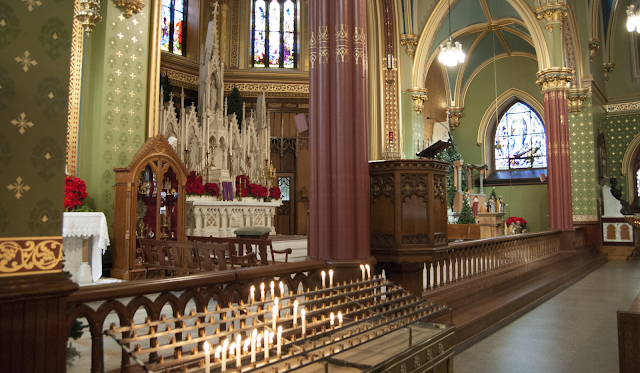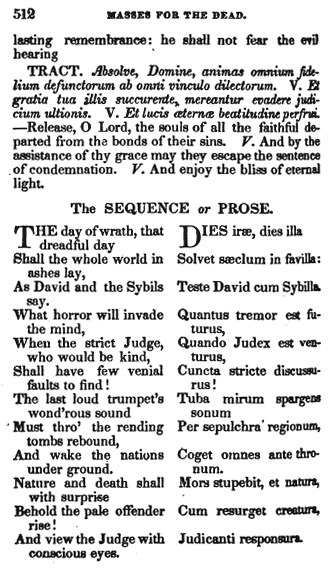Guest article by Jeff OstrowskiAs if it were yesterday, I remember complaining to my mother about a sermon that struck me as rather long and rambling. She replied to me, "I wish they would teach our young priests what they used to: Say what you're going to say, say it, and then say what you said." In other words, have a clear point and stick to it no matter what. In this second installment of my six-part series, I shall do my best to follow my mother's wise advice, but it will not be easy with such an elaborate topic. The subject of Part 2 is "Mass Propers & Ordinaries in the
St. Edmund Campion Missal & Hymnal for the Traditional Latin Mass." Part 1 of the series can be found
here [url].
The overriding idea behind the Campion book was to "enshrine the Mass." In so many of the "typical" Latin Mass daily missals, which are usually reprints of books published in the early 20th century, it seems as though the publishers were trying to cram onto each page as much text as could possibly be made to fit. Considering the printing capabilities in those days, this technique was (perhaps) understandable, but I would argue that such an approach is unacceptable in the year 2013. For one thing, the font size in such publications is extremely small and hard to read (especially for the elderly). Secondly, numerous page turns are required. Finally, the result of such "cramming" is not
beautiful.
Therefore, in this article, I will describe our attempt to "enshrine the Mass," and when the books start shipping in early February, those who purchase it may judge for themselves the extent to which we met our goal. I should briefly mention that extensive research on possible layouts was undertaken prior to publication. Here is a sample page from an 1843
Missal for the Laity (Eugene Cummiskey, Philadelphia):
![]()
To view a sample page from an 1885 book (D. & J. Sadlier & Co., New York), please
click here [image]. Much to the delight of those interested in these historical editions (and I am one!), many such books were printed through the years, and it is important for publishers to at least be cognizant of these past editions, carefully noting the advantages and disadvantages of each approach.
The goal with the Campion book was for each of the 992 pages to be
as unified as possible in layout, treatment of ligatures, spellings, accents, rubrical instructions, and all the other choices publishers must decide upon. Many readers doubtless know that some Latin words have been spelled differently through the centuries: coeli vs. caeli, repulit vs. reppulit, and so forth. Rev. Brian Austin, FSSP, has written about a decree from the Sacred Congregation of Rites (November 1961) which specified certain orthographical changes for
official liturgical books, but that ruling does not govern books for the laity. Incidentally, several generous volunteers spent hours and hours combing through the proofs in search of errors. Some readers might be surprised to learn that even the most distinguished publications contain typos and errors. For instance, note the way "ciborium" and "the" are spelled in
Mass & Vespers (Solesmes, 1957):
![]()
Even the famous
Hymnal Noted (1851) has errors, as Latin scholars will notice by clicking
here [image].
Now for a brief word about the physical qualities and dimensions (although the best way to judge these is to purchase the book, which will begin shipping in early February). The Campion book is 992 pages long. By way of comparison, GIA's
Worship IV Hymnal is 1232 pages long, and CCW's
Vatican II Hymnal is 750 pages long. The Campion book has a gorgeous hardcover. GIA's
Worship IV has a very slippery cover, which makes that heavy book quite unpleasant to hold, in this author's opinion. In the Campion book, 872 pages are black and white, while 120 are full color. The pages are incredibly opaque, and the durable, Smyth Sewn binding is the absolute highest quality available and will last for decades. The book is 9x6, just like most hymnals. Some people are amazed that such a book is being sold at such a low price (as opposed to most Sunday Missals, which cost 3-4 times as much), but it must be remembered that the
purpose of this book is not to make money — it is to promote the Traditional Latin Mass.
To view sample pages from the
Mass Propers from the Campion book, please click on the following:
*
Mass Propers (sample) [pdf]
The Campion book uses a very large font size, especially compared to other missals for the laity. Please click on the following to view this contrast:
*
Comparison of font size (Mass Propers) [pdf]
Notice that our capital letters are placed without "collisions." Also, notice that we give Latin & English equal weight. In order to save space, some missals shrink the Latin down to a much smaller size — this makes the pages look quite uneven, whereas the layout ought to be balanced, just like the sacred liturgy is balanced. A priest who says the Traditional Mass on a daily basis told me that to shrink down the Latin is like "discrimination" in his opinion.
To view sample pages of the
Kyriale from the Campion book, please click on the following:
*
Kyriale (sample) [pdf]
How large is the size of our (complete) Kyriale compared to other missals? Please examine the following:
*
Comparison of Kyriale print size [pdf]
The Campion book contains all possible feasts that could ever occur on a Sunday or Holy Day according to the 1962 Missal, as the reader can see by viewing this
chart [pdf].
One of the major drawbacks of so many daily missals is the excessive amount of page-turning required. In our book, we worked very hard to eliminate all page turns. To give an example, there are special feasts which occur depending on the number of "Sundays after Pentecost." Most missals just say, "For these feasts, take the Propers from here and the readings from here." We find this totally unacceptable, so we followed the example of Fr. Francis Xavier Lasance (1860-1946), and carefully printed each of the
Extra Sundays after Pentecost [pdf].
Speaking of Fr. Lasance, his works served as the basis for the entire Campion book. Looking back, nothing would have been easier than to "copy and paste" all the Mass texts (Introits, Collects, Epistles, etc.) from random sources. However, it seemed important to provide
unity of style throughout the book, and for this reason, we scrupulously adhered to Fr. Lasance: his spellings, punctuation, capitalization, etc. There were any number reasons we decided the work of Fr. Lasance was "the best" for our purposes. However, if I were forced to summarize all of them into a single sentence, it might go something like this:
The elegant English translations found in the works of Fr. Lasance are quite literal, conveying the beauty of the ancient Latin prayers in a marvelous way that is "hieratic" (Thee, Thou, etc.) yet able to be understood perfectly even by school children. To see our book juxtaposed with that of Fr. Lasance, please click on the following:
*
Side-by-side Campion & Lasance [pdf]
The following video also has several close up views of the Mass Propers and Gregorian chant
Editio Vaticana Kyriale:
Needless to say, I have not exhausted the subject of the Mass Propers & Ordinaries, especially with regard to the line art we have used to enhance these. However, this discussion will have to wait for the next installment of the series.
![]()
![]()


















































